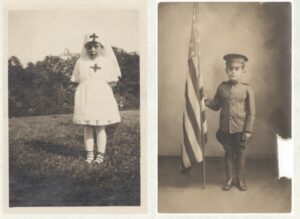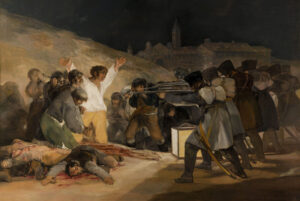Military archaeology solves a literary mystery.
On average, 15 skeletons are recovered each year from the woods around Verdun. They are found entirely by chance—by a forester or a hiker—and, unless something plainly indicates the dead man’s identity, the bones are placed in the Douaumont ossuary there. It is not surprising that remains are still turning up: The archivist at the battlefield museum at Fleury estimates that 80,000 bodies lie uncollected at Verdun.
Eighty thousand less 21. In November 1991, the remains of 21 soldiers were recovered from a grave southeast of Verdun on forested heights above the Meuse River. Those skeletons, unlike most, were found not by chance but at the end of 15 year search–which has solved one of the enduring literary mysteries of this century. We at last know the fate of a major literary casualty of the First World War, the French novelist Alain-Fournier, who had been an MIA since September 22, 1914.
His real name was Henri Alban Fournier, and at the time of his disappearance he was 28 years old and the author of just one published novel. But what a novel. Le Grand Meaulnes–or as we know it in English, The Wanderer–has to be one of the most haunting evocation of adolescence ever written. It too is about a search (by the wanderer of the title), for an elusive and beautiful young woman, and its story unfolds amid a labyrinth of forests and marshland and roads not taken in the part of central France where Fournier grew up, the son of country schoolteachers. Fournier’s novel can be viewed as a eulogy not just to the end of youth but to an isolated ad complacent rural way of life, much romanticized by him, that the war would doom. As the novelist John Fowles has written, The Wanderer “is a book one never quite forgets, a book like a secret garden.”
Fournier was living in Paris when the war began. He had worked for a literary gossip columnist and had briefly been the French tutor for a philosophy student from Harvard, T.S. Eliot. This darkly handsome young man from a peasant background found himself a player in the bedroom farces of the upper bohemian world in which he now moved. In October 1913, The Wanderer appeared, to a critical reception mixed enough to disappoint the young author. Its reputation would build slowly.
A lieutenant in the reserves, Fournier was called up in August 1914, and he joined his unit, the 288th Infantry Regiment. “I don’t know exactly where God is in this war,” he told a friend, “because none of us can solve the riddle of existence, but I know that I’ll be shot down only when He wants, how He wants, and where He wants.” For all his wild life, Fournier remained devout, fatalistically so, always the boy from the country.
The 288th went into action south of Verdun, at a time when the Germans were threatening to pour over the heights of the Meuse and engulf the fortress complex. (We often overlook the seriousness of that first threat). On September 22, Fournier, with a captain and a platoon of riflemen, pushed into a beechwood forest looking for the enemy. The two armies were only then beginning to dig trenches; lines were still uncertain. Somewhere amid the trees, the platoon apparently blundered into a German ambush. A survivor last saw Fournier dashing forward as he fired his officer’s revolver. Then he vanished, almost like someone out of his own novel.
In 1977, Michel Algrain, an admirer of Fournier, began combing official military records for clues to the author’s final moments. Algrain eventually enlisted the services of Claude Regnault, a retired teacher of German, to read through the records of the 6th Regiment of Prussian Grenadiers, the unit against which the 288th fought on the day Fournier disappeared. The two men succeeded in pinning down the location of the opposing regiments. From there, it was more or less a matter of vector geometry to ascertain where the body of the writer might be found. Their computations and maps in hand, Algrain and Regnault narrowed their search to a reasonable small area and applied for permission to excavate.
It is illegal to dig at Verdun. The secretary of state for veterans and war victims is the only organization that can legally exhume bodies from any of the national battlefield sites in France, and it had never given private individuals permission to do so. In 1990, Algrain’s request was turned down. So he went back to the archives and came upon a document that pinned down the 23rd Company (Fournier’s) of the 288th to an area measuring less than two acres. Poking around in the woods, Algrain and a group of amateur investigators around a 15-foot-long mound that seemed promising. Algrain and his friends again applied for permission to dig–this time with limited backing from the Lorraine Archaeological Service. In the spring of 1991, the men were told they could conduct microwave soundings, and what they spotted—a leather boot and clothing—convinced authorities that they were onto something.
In October, Frédéric Adam of the Lorraine Archaeological Service was put in charge of an excavation. The archaeologists excavated an area measuring 17 by eight and a half feet, in which two rows of ten bodies had been laid head-to-foot. A 21st body had been placed in the middle, across five of the others.
According to Frédérique Boura, another of the archaeologists, a government historian at the grave site reached certain conclusions long before the archaeologists did. He recognized the skeletons as those of reserve soldiers who had died in 1914. Certain equipment used in 1914 and recovered from the graves—brass buttons decorated with flaming grenades, and the nails used in the boot soles—had been changed by the following year. Other recovered artifacts—1886-model cartridge belts and 1881-model boots—showed that the soldiers had been in a reserve unit, such as the 288th. (New models were given to regular-army units.)
Adam, Boura, and the other archaeologists sought more detailed conclusions. They lifted the skeletons individually so as to preserve intact the personal effects that lay closest to each one. “A bundle of presumptions” emerged with those effects, Adam said. Sixteen aluminum identity discs worn on the wrists—five of them readable only after extensive laboratory work—suggested 16 identities. By analyzing the skeletons and reading military files (stature, age, dental records), researchers confirmed that they had recovered the remains of those 16 men. Three of the five other skeletons, including that of Fournier, were identified without the benefit of an identity disc.
Those three skeletons, like many of the others, had clothing attached to them. The pieces of uniform were of the red-and-blue style worn by French soldiers in 1914; by 1915 they had mostly changed to horizon blue. A captain, a lieutenant, and a sergeant were identified tentatively from their rank insignias—as the others had been by their identity discs. Adam believes the identity discs of those three men were taken as souvenirs by German soldiers.
The lieutenant a tattered coat sleeve bore the double gold bars, a collar the numerals of the 288th was believed to be Fournier. Army records showed that he was the only lieutenant the 288th reported missing in this sector of the Meuse Heights in 1914. In addition, in 1,561 days of war, this particular site saw combat only once—on September 22, 1914. (The German advance here stopped on that day, close to Fournier’s last billet, the village of Vaux-les-Palameix; the lines did not budge again.)
Adam measured the skeleton: it matched Fournier’s stature. He calculated its age at death—about 30—and that was right too. Other evidence came from informal dental records: Fournier had written to his family shortly before he disappeared. telling them about problems that he had with a particular tooth. The skeleton showed decay in that tooth. Fournier’s body was formally identified in June 1992, almost 78 years after he died.
In trying to determine the circumstances of the writer’s and his comrades’ deaths, the archaeologists have laid at least one frequently voiced suspicion to rest: that Fournier was executed after being taken prisoner. Nineteen of the skeletons showed “definite signs” of injury from projectiles. Adam said, and there is “no reason to doubt” that every man died as a result of actions normal in combat. Yet six of the skulls—not including Fournier’s–had been pierced through, as though by a pistol at close range. Since wounded soldiers are sometimes killed as an act of mercy, that is how these men’s deaths have been labeled. Further substantiating that idea, most of those six skeletons show signs of other injuries. Since Fournier’s skeleton does not show signs of injury, there can be no telling now how he died.
Interesting details about demographics and daily life emerged from the grave site. The teeth of nearly all the soldiers, for instance, were misshapen or missing. In addition, the enlisted men were small (and possibly malnourished as boys): Their average height was only five feet three inches. The two officers, who came from the bourgeoisie, were five inches taller. A number of religious medallions and bits of knitted underclothes offer an understated but poignant testimony to these young men’s thoughts of home and family while they were at war. (Fournier is known to have worn two religious medallions, both of which were missing from his skeleton.) Some of the soldiers had wrapped coins in paper to keep them from jangling in their pockets.
Unmarked World War I grave sites such as the one near Vaux-les-Palameix are an invaluable and untapped source of information. The law prohibiting the exhumation of remains dates to July 1919 and obviously was needed at the time to prevent droves of relatives from searching for loved ones. Archaeologist Boura, however, makes a plea for easing controls and letting archaeologists go to work on the sites.
Boura goes on to explain that 1914 grave sites predate the efficient (but historically less valuable) mass-burial procedures implemented later in the war. Unlike the established military cemeteries, the unmarked graves in the area are threatened by development, which is expected to level half of the Verdun forest in the next 15 to 20 years. Treasure hunters have also targeted 1914 graves in their search for salable artifacts.
The remains of the 21 soldiers were reinterred together on November 10, 1992. Gold coins, pocketknives, and mirrors were returned to their families—when families could be tracked down. In Fournier’s case, one mystery may have been solved, but another, that of his potential, must remain unanswered. “There’s a wonderful book to be written about this war, if God will help me,” Fournier had told a friend just before he was killed. MHQ
ROBERT DOUGLAS HILL, formerly an associate editor of this magazine, is a free-lance writer in France.
[hr]
This article originally appeared in the Autumn 1993 issue (Vol. 6, No. 1) of MHQ—The Quarterly Journal of Military History with the headline: A Bundle of Presumptions
Want to have the lavishly illustrated, premium-quality print edition of MHQ delivered directly to you four times a year? Subscribe now at special savings!





